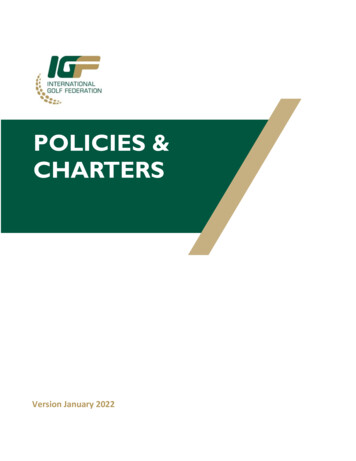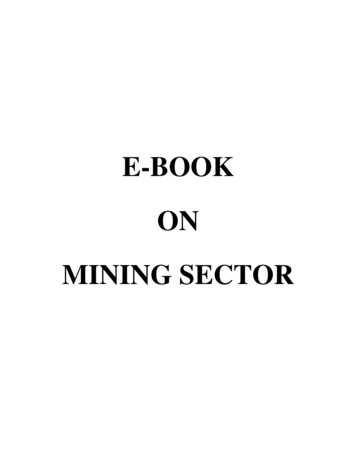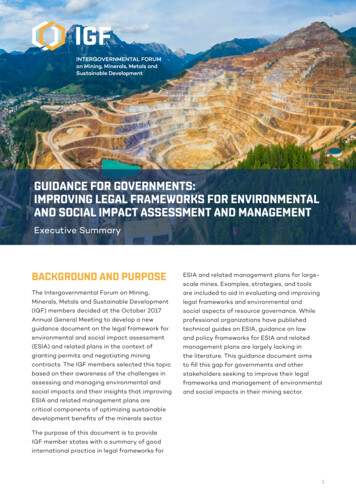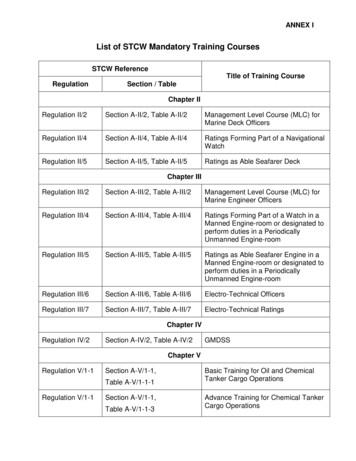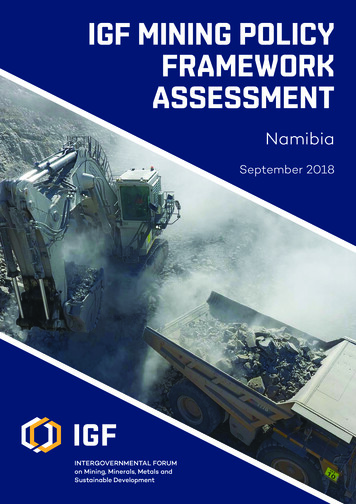
Transcription
IGF MINING POLICYFRAMEWORKASSESSMENTNamibiaSeptember 2018
2018 The International Institute for Sustainable DevelopmentPublished by the International Institute for Sustainable DevelopmentThe International Institute for Sustainable Development (IISD) is an independentthink tank championing sustainable solutions to 21st–century problems. Ourmission is to promote human development and environmental sustainability. Wedo this through research, analysis and knowledge products that support soundpolicy-making. Our big-picture view allows us to address the root causes of someof the greatest challenges facing our planet today: ecological destruction, socialexclusion, unfair laws and economic rules, a changing climate. IISD’s staff of over120 people, plus over 50 associates and 100 consultants, come from across theglobe and from many disciplines. Our work affects lives in nearly 100 countries.Part scientist, part strategist—IISD delivers the knowledge to act.IISD HEAD OFFICE111 Lombard AvenueSuite 325Winnipeg, ManitobaCanada R3B 0T4IISD.org @IISD newsIISD is registered as a charitable organization in Canada and has 501(c) (3) statusin the United States. IISD receives core operating support from the Governmentof Canada, provided through the International Development Research Centre(IDRC) and from the Province of Manitoba. The Institute receives project fundingfrom numerous governments inside and outside Canada, United Nationsagencies, foundations, the private sector and individuals.The IGF is a member-driven organization which provides national governmentsthe opportunity to work collectively to achieve their sustainable mining goals.It is devoted to optimizing the benefits of mining to achieve poverty reduction,inclusive growth, social development and environmental stewardship. The IGFserves as a unique global venue for dialogue between its 67 member countrygovernments, mining companies, industry associations and civil society.Secretariat functions are provided by the International Institute for SustainableDevelopment, which manages the day-to-day operations of the IGF and provideslogistical, administrative and strategic support for its activities. The program isundertaken with the financial support of the Government of Canada providedthrough Global Affairs Canada.IGF/IISD OTTAWA OFFICE220 Laurier Avenue W.Suite 1100Ottawa, OntarioCanada R3B 0T4IGFMining.org @IGFMiningIGF Mining Policy Framework Assessment: NamibiaSeptember 2018Written by Alec Crawford, Jessica Mooney and Harmony MusiyariraRECOMMENDED CITATION:Intergovernmental Forum on Mining, Minerals, Metals and Sustainable Development (IGF). (2018). IGF MiningPolicy Framework Assessment: Namibia. Winnipeg: IISD.Secretariat hosted bySecretariat funded by
ABOUT THE MPF ASSESSMENTSERIES OF REPORTSWith support from the Government of Canada, the Intergovernmental Forum on Mining, Minerals,Metals and Sustainable Development (IGF) is working with a voluntary selection of its member statesto help them operationalize practices consistent with the IGF’s Mining Policy Framework (MPF). Thefirst assessments were carried out in 2014 in the Dominican Republic, Madagascar and Uganda.Based on the success of these initial evaluations, the IGF will conduct three or four assessments eachyear, in response to member requests.The MPF assessment process itself is made up of two main steps. First, the MPF assessment teamevaluates relevant national, regional and international laws, policies, conventions and administrativeframeworks for mining and minerals development and management relative to the six themes ofthe MPF: the Legal and Policy Environment, Financial Benefit Optimization, Socioeconomic BenefitOptimization, Environmental Management, the Post-Mining Transition, and Artisanal and Smallscale Mining (ASM). This work is done both through desk- and field-based research involving diversestakeholders. The assessment identifies key strengths, weaknesses and gaps in the country’s mininglaws and policies, as compared to the international best practices outlined in the MPF, which helpsmeasure the readiness of the member state to implement the MPF through its existing governmentmeasures. Building on the outcomes of this assessment process, the second phase of the projectinvolves working with the participating state to develop a capacity-building and technical supportprogram that addresses key weaknesses and gaps, in the hopes that these strengthened capacitiesand increased understandings can enhance national legislation and policies, thereby optimizing thecontribution of the mining sector to sustainable development.This report presents the assessment for Namibia, with a view toward the following: helping thegovernment target its efforts in implementing the MPF; informing capacity-building efforts; andallowing for monitoring of progress over time. The authors would like to thank their colleagues fromthe Government of Namibia, particularly those at the Ministry of Mines and Energy, for their help andsupport with this project. A special thanks to Isabella Chirchir and Minsozi Sibeso for their invaluablehelp and support in conducting this assessment.iii
ACRONYMSAUAfrican UnionASMartisanal and small-scale miningCBNRMcommunity-based natural resources managementCITESConvention on International Trade in Endangered Species of Wild Fauna and FloraCoMChamber of MinesCSRcorporate social responsibilityDEADirectorate of Environmental AffairsEAPEnvironmental Assessment PractitionerECEnvironmental CommissionerEIAenvironmental impact assessmentEMAEnvironmental Management ActEMPEnvironmental Management PlanEPLsExclusive Prospecting LicencesEPZexport processing zoneGDPgross domestic productGNIgross national incomeGRNGovernment of the Republic of NamibiaGSNGeological Survey of NamibiaIFCInternational Finance CorporationIGFIntergovernmental Forum on Mining, Minerals, Metals and Sustainable DevelopmentIISDInternational Institute for Sustainable DevelopmentMARCMinerals Ancillary Rights CommissionMAWFMinistry of Agriculture, Water and ForestryMCMining CommissionerMETMinistry of Environment and TourismMFMRMinistry of Fisheries and Marine Resourcesiv
MGECWMinistry of Gender Equality and Child WelfareMITSMEDMinistry of Industrialization, Trade and Small and Medium Enterprise DevelopmentMMEMinistry of Mines and EnergyMPFMining Policy FrameworkNCENamibian Chamber of EnvironmentNDPNational Development PlanNEPLnon-exclusive prospecting licenceNGOnon-governmental organizationNPCNational Planning CommissionNUSTNamibian University of Science and TechnologyPPPpublic–private partnershipQAQCquality assurance and quality controlTSFtailings storage facilitySACUSouthern African Customs Union (South Africa, Botswana, Swaziland, Namibia and Lesotho)SADCSouthern African Development CommunitySEAstrategic environmental assessmentSMEssmall and medium enterprisesUNUnited NationsUNDPUnited Nations Development ProgrammeVATvalue-added taxv
IGF Mining Policy Framework Assessment: NamibiaEXECUTIVE SUMMARYThis report presents an assessment of Namibia’s readiness and capacity to implement the MiningPolicy Framework (MPF) of the Intergovernmental Forum on Mining, Minerals, Metals and SustainableDevelopment (IGF). The IGF Secretariat and local experts conducted the assessment betweenNovember 2017 and April 2018; the process involved an extensive desk-based review of key domesticand international laws and policies, as well as a 10-day field visit to the country, during which theproject team met with a broad array of stakeholders from government, civil society, internationalorganizations and the private sector. The assessment phase of this project concludes with this report.The assessment team identified the following key strengths in Namibia’s mining laws and policies: Namibia has a consolidated and extensive geological database, generated and maintained bya skilled and well-staffed Geological Survey Department. The mining sector generates a significant amount of revenue for Namibia through a varietyof mechanisms (including taxes, royalties, equity, fees and levies), and the rates applied aregenerally regarded as fair, regionally competitive and equitably applied across the sector. Provisions within the Minerals Policy, supported by related legislation, encourage miningentities to prioritize the employment of Namibians in their operations, particularly women andformerly disadvantaged people, and to promote local procurement and contracts for serviceprovision. The Environmental Management Act and its regulations, including requirements around thedevelopment of environmental impact assessments (EIAs) and environmental managementplans (EMPs), as well as the environmental clearance certificate (ECC) process, are strong,and the ministry proactively continues to try to improve upon it. Artisanal and small-scale mining is a key pillar of the Minerals Policy, and efforts areunderway to promote its economic and legal formalization.The assessment team identified the following key gaps and weaknesses in Namibia’s mining lawsand policies: Key pieces of legislation and policy, including the Minerals (Prospecting and Mining) Act, theMinerals Policy, and the Water Act, are in need of revision, or are in a process of revision thatis often seen as too lengthy and opaque. Stakeholders note that uncertainty around the content of future policies and laws couldinfluence future investments in exploration. Legislation on occupational health and safety is outdated, its enforcement is limited, and itdoes not reflect the unique operating risks of the mining sector. Water and waste management legislation is outdated, and its enforcement is poorlyresourced, ad hoc and uncoordinated. Mine closure, rehabilitation and the post-mining transition—and financing requirements for allthree—are not adequately addressed in existing legislation or policy. There are no mechanisms in place or in legislation to improve the savings of ASM miners, toestablish more acceptable forms of financing to improve access to credit, or to encourageresponsible investment in the sector. Limited government revenues (taxes or royalties) are generated from small-scale mining, andprogress on strengthening the appropriateness, viability and transparency of policies andsystems for the collection, management and reinvestment of ASM revenue has been slow.vi
IGF Mining Policy Framework Assessment: NamibiaThe major strengths and gaps of Namibia’s mining policy and legislation, across all six pillars of theMPF, are summarized in Table ES1.TABLE ES1. KEY STRENGTHS AND GAPS OF EACH PILLAR OF THE MPFMPF THEMELegal and PolicyEnvironmentLEVEL OFPROGRESSTOWARD MPFSTANDARDSMEDIUMSTRENGTHSGAPS Namibia has a consolidated andextensive GIS-based geologicaldatabase that includes asignificant historical record andmaps covering a broad range ofdata types. Geological information is publiclyavailable. The Minerals (Prospecting andMining) Act and Mining Policy areboth under review to incorporatechanging knowledge and bestpractice. The Minerals (Prospecting andMining) Act stipulates a fair andtransparent process for licensing. Data and reporting requirementsfor permits and mining claimapplicants are made clear in theAct. Applicants for mining licencesare required to submit anenvironmental impact assessment(EIA) prior to the granting of thelicence. EIAs are to be completed by anindependent third party. The protection of cultural heritageand national monuments isaddressed in the permit applicationprocess through the EIA. Full community consultation isrequired as part of the EIA process. The Minerals (Prospecting andMining) Act and Minerals Policyare largely outdated, and onesupporting legislation is similarlyout of date (i.e., the Water Act of1956). Geological data derived fromexploration companies is seen asincomplete and poorly archived,and a lost resource for Namibia. Mine closure is largely absentfrom the Minerals (Prospectingand Mining) Act, includingfinancial assurances for closure. The Minister of Mines and Energyhas not, according to the currentAct, had the ability to develop andpass mining regulations based onthe legislation. The permitting process shouldbe completed in a timely,unambiguous and consistentmanner, but in practice there canbe significant delays and opacity. Stakeholders noted the needfor increased transparency inthe granting or rejection of minepermits and licences.vii
IGF Mining Policy Framework Assessment: NamibiaMPF THEMEFinancial BenefitOptimizationLEVEL OFPROGRESSTOWARD MPFSTANDARDSMEDIUMSTRENGTHSGAPS Mining generates a significantamount of revenue for the country,through a variety of mechanismsincluding taxation (corporate,income, VAT), royalties, fees andequity. The rates applied for taxes androyalties are largely perceivedas fair among private sectoractors, and competitive with otherSouthern African DevelopmentCommunity (SADC) jurisdictions. Namibia’s Affirmative Action andProcurement policies are designedto promote increased domesticinvestment and ownership in thesector. Revenues from the sector gotoward broad support for nationaldevelopment. There are not multiple layers ofgovernance applied to thoseoperating in the sector, simplifyingthe legal regime for mining inNamibia: the rules are largely thesame for all stakeholders. The Ministry of Finance hasdivisions devoted to investigatinglarge taxpayers and to combattingtransfer pricing. The Auditor General has thecapacity to audit results reportedby mining companies. There are no mechanisms orprovisions in place in the tax codeor other legislation to addresscommodity price volatility. The licensing condition that newmineral exploration only happenwith at least 5 per cent localNamibian ownership is seenby stakeholders as a barrier toinvestment. The review process for mininglaw and policy is seen as toolengthy and slow, and is perceivedby investors as a source ofuncertainty, discouraginginvestment. Mining licence fees are low. The High Value Minerals Handlinglevies on semi-precious stonescan act as a deterrent todomestic value addition. Certain mining companies havebeen granted access to thegovernment’s Export ProcessingZone (EPZ) and its preferential taxrates, giving them an advantageover other companies operating inthe sector. Limited links have been madebetween mining permits andNamibia’s national policyobjectives. Transparency on mining revenuemanagement is limited.viii
IGF Mining Policy Framework Assessment: NamibiaMPF THEMESocioeconomicBenefitOptimizationLEVEL OFPROGRESSTOWARD MPFSTANDARDSMEDIUMSTRENGTHSGAPS The stated vision of Namibia’sMinerals Policy includes theresponsible development of thecountry’s natural resources, andthe government’s commitmentto ensuring that these resourcesmake a sustainable contribution tothe socioeconomic development ofthe country. Evaluating the socioeconomicbenefits of mining is included inthe EIA process, prior to permittingand licensing. The legal framework foroccupational health and safetyin the mining sector is enforcedby the MME. The Chief Inspectorof Mines has the power torecommend suspension orrevocation of permits for breachesor contraventions. The new Public Private PartnershipAct provides a legal frameworkto promote private sectorparticipation in the provisionsof public services, includinginfrastructure. Provisions in the Minerals Policy andin the special conditions attachedto exclusive prospecting licences(EPLs) and mining licences directmining companies to prioritize theemployment of Namibians in theiroperations, particularly women andformerly disadvantaged people. Local procurement and contractsfor service provision are promotedthrough the Minerals Policy, andare supported through the PublicProcurement Act (2015). The Minerals Policy encouragesthe mining sector to participatein corporate social responsibility(CSR) program, though these arevoluntary. In line with the Affirmative ActionAct, NDP5 and Vision 2030, theminister can impose specialconditions prior to granting amining licence or EPL, which caninclude provisions to improve thesocioeconomic context in Namibia. No requirement exists forcapacity-building programsfor communities to understandthe potential environment andsocioeconomic impacts identifiedduring the EIA process. Regulations for the health andsafety of persons employedor otherwise present in or atmines made under the Minerals(Prospecting and Mining) Act havenot been finalized despite multiplerevisions. The Labour Act does notspecifically regulate theunique risks associated withOccupational Health and Safetyin mining operations. The mining sector is required toreport sex-disaggregated datato the Ministry of Labour, but thisinformation does not appear tobe shared across governmentministries.ix
IGF Mining Policy Framework Assessment: NamibiaMPF THEMEEnvironmentalManagementLEVEL OFPROGRESSTOWARD MPFSTANDARDSMEDIUMSTRENGTHSGAPS An environmental clearancecertificate (ECC) is required priorto undertaking a number of theactivities associated with mining,and compliance with the act isgenerally strong. Special and stringent conditionsare placed on ECCs for projectsthat pose high or significant socialor environmental risks. The Environmental ManagementAct (EMA) empowers theEnvironmental Commissioner tomonitor compliance with the actand with conditions stipulatedin ECCs. The EnvironmentalCommissioner can suspend orcancel an ECC for non-compliance. An environmental managementplan (EMP) is required as partof the environmental clearancecertificate application. While largely focused on research,the Geological Survey of Namibiaalso has programs in place formonitoring mineral contaminationat mining operations, and has thetechnical skills, knowledge, abilityand equipment required to conductthis monitoring. Information andknowledge generated through thismonitoring is shared with the METto strengthen their compliancemonitoring. The Environmental ManagementAct, through its EIA process,requires that mining companiesidentify and minimize the likelihoodof impacts beyond the mine site. The Minerals (Prospecting andMining) Act makes referenceto good practices with respectto mining, prospecting andreconnaissance. The government has drafted aPolicy for Prospecting and Miningin Protected Areas and NationalMonuments, which will allowthese activities in these regionsonly under conditions of strictenvironmental management andafter the completion of a full EIA. The Water Act of 1956, whichgoverns the use of waterresources, is outdated, and theWater Resources ManagementAct (2013) was passed but is notenforced. The Ministry of Agriculture,Water and Forestry (MAWF) haslimited capacities to enforce andapply appropriate penalties fornot complying with the WaterAct, namely due to financialand human resources, whilethe penalties set in the act areinadequate. Procedures to renew an ECC arenot included in the EMA or itsregulations. The Ministry of Environment andTourism (MET) has the mandateto regulate environmentalperformance, but lacks thetechnical skills, resources andequipment to regulate effectively. The draft Policy for Prospectingand Mining in Protected Areasand National Monuments has notyet been adopted. The implementation of the effluentpermitting process for miningentities is inconsistently applied.Namibia does not have its owneffluent discharge guidelines andrelies on South African standards. Environmental compliancereporting by companies tothe MET occurs on a biannualbasis; however, the MET haslimited resources for reviewingenvironmental clearancecertificates and biannual reportsin a timely manner. There is no EnvironmentalPractitioners Act and norequirement for consultantsconducting EIAs to be registeredor certified. It is unclear to what extent miningentities are reporting volumes ofwater abstracted and discharged,and its quality, to the MAWF asrequired. MAWF and MET have a disjointedapproach to enforcing compliancewith water or discharge permitsrequirements.x
IGF Mining Policy Framework Assessment: NamibiaMPF THEMELEVEL OFPROGRESSTOWARD MPFSTANDARDSSTRENGTHSGAPS No national noise or air qualitystandards exist for Namibia. The Pollution Control and WasteManagement Bill remains in draftform and should be finalized byparliament to become an act. Neither MAWF nor MME have aclear legal framework to regulatesand mining. There is no legal requirement forcompanies operating in Namibiato comply with internationalstandards or guidelines for keyenvironmental risk areas, forexample in the design of tailingsstorage facilities. The EMA does not requiremining entities to commissionindependent experts to reviewand report to government priorto development approval, designchange or at regular intervals. The Environmental Commissionerhas limited ability to enforce finesor penalties for non-compliancewith the law; cases that requirelegal enforcement are handedover to the police.Post-miningTransitionLOW The Minerals (Prospecting andMining) Act includes some text onclosure and rehabilitation, such asthe polluter pays principle. The Chamber of Mines hasproduced a framework for mineclosure that is guided by its Codeof Ethics, and which is endorsed byits members. Environmental Management Plansaddress mine closure at a highlevel. The EMA is in line with modernlegislative trends on mine closure. The Minerals Policy states thatbefore a mining licence is granted,there should be a final mineclosure plan together with afunding mechanism that describeshow the company will deal withmatters like groundwater pollution,soil degradation, wind pollutionand infrastructure. There is no legal framework formine closure or relinquishment. The EMA and the Minerals Policyexplicitly refer to rehabilitationas a requirement but they lack aspecific regulation and authorizedagency, and sufficient resourcesto implement these requirements. There is no formal system forhandling the approval of closureplans. There is no mandatory financialassurance mechanism to coverthe costs of mine closure. There are no incentives in placefor progressive rehabilitation. The penalties for inadequateclosure are very low and usuallycheaper than proper closure. There is a reluctance torehabilitate abandoned mines. The legal framework does notrequire periodic assessment andauditing of mine closure plansxi
IGF Mining Policy Framework Assessment: NamibiaMPF THEMEArtisanal andSmall-ScaleMiningLEVEL OFPROGRESSTOWARD MPFSTANDARDSMEDIUMSTRENGTHSGAPS Mining Claims indicate thata process is in place for theformalization of small-scale mining. ASM is a pillar of the Minerals Policy. Child labour is not prevalent in theASM sector in Namibia. The Ministry of Mines and Energy,through the Minerals AncillaryRights Commission, can act asa mediator between ASM andlandowners should disputes arise. There is limited understandingamong miners of mininglegislation, includingenvironmental management andoccupational health and safety. There is a general lack ofcoordination among governmentministries with regard to supportservices for the sector. There is a lack of funding fortraining, education and innovationprogramming in the ASM sector. There are no mechanisms inplace or in legislation to improvethe savings of ASM miners, toestablish more acceptableforms of financing to improveaccess to credit, or to encourageresponsible investment in thesector. Minimal revenues are collectedfrom small-scale miners. MME capacities with regards toASM are largely limited to geology,and do not include areas such asbusiness development, marketingor gemology. There is a general lack ofgeological mapping of semiprecious stones. There are limited efforts in placeto encourage initiatives for fairtrade or conflict-free certification. The national legislation onworkplace health and safety doesnot apply to individuals workingin ASM, particularly those withoutmining claims. There are no defined ASM zones.xii
IGF Mining Policy Framework Assessment: NamibiaTABLE OF CONTENTS1.0 INTRODUCTION. 12.0 NAMIBIA: THE NATIONAL CONTEXT. 2Economic Context. 3Gender Context. 3Environmental and Climate Context.43.0 NAMIBIA: THE MINING CONTEXT. 54.0 NAMIBIA: KEY MINING INSTITUTIONS, LAWS AND POLICIES.8Key Institutions.8Domestic Law and Policy.10International Commitments.115.0 ASSESSMENT: NAMIBIA AND THE MINING POLICY FRAMEWORK .12Legal and Policy Framework. 12Financial Benefit Optimization.16Socioeconomic Benefit Optimization. 19Environmental Management.22Environmental Law and Policy in Namibia.24Post-Mining Transition.27Artisanal and Small-Scale Mining. 306.0 RECOMMENDATIONS. 34Priority Area 1: Mine Closure and Post-Mining Transition .34Priority Area 2: Legal and Policy Context .35Priority Area 3: Environmental Management.35Priority Area 4: Artisanal and Small-scale Mining.36REFERENCES . 37ANNEX: LIST OF LAWS AND POLICIES REVIEWED. 39ANNEX: LIST OF CONSULTED STAKEHOLDERS.41xiii
IGF Mining Policy Framework Assessment: Namibia1.0 INTRODUCTIONMining is a central pillar of Namibia’s economy and its future development. The country is heavilydependent on the extraction and processing of minerals for export: mining accounted for 12.2 per centof gross domestic product (GDP) in 2017, and provides more than 50 per cent of foreign exchangeearnings (Chamber of Mines, 2017; CIA, 2018). While mining presents a significant opportunity forgrowth and development, Namibians—including the government, civil society and the private sector—must work to ensure that meeting the needs of today’s stakeholders does not compromise the needsof future generations.For the mining sector to make a strong, positive contribution to Namibia’s sustainable development, astrong legal and policy framework that maximizes the benefits accrued to the nation and to communitiesis required, a framework that promotes the development benefits of mining while upholding strongenvironmental and social standards. Mining can play a significant role in a nation’s long-term socialand economic development: it can generate revenues for the government; provide employment, skillsdevelopment and business opportunities for local communities; and support investments in education,health, clean technology and infrastructure. At the request of the Government of Namibia, and incollaboration with the Ministry of Mines and Energy (MME), the Intergovernmental Forum on Mining,Minerals, Metals and Sustainable Development (IGF) is working to advance such policies and goodgovernance practices in Namibia, through the use of its Mining Policy Framework (MPF).This assessment report first presents Namibia’s development, mining and legal contexts. It thenhighlights the key strengths and gaps in Namibia’s mining policies and laws, across all six of theMPF’s thematic areas, before making recommendations for further capacity building and reform.The six MPF thematic areas are: the Legal and Policy Environment, Financial Be
The MPF assessment process itself is made up of two main steps. First, the MPF assessment team evaluates relevant national, regional and international laws, policies, conventions and administrative frameworks for mining and minerals development and management relative to the six themes of


